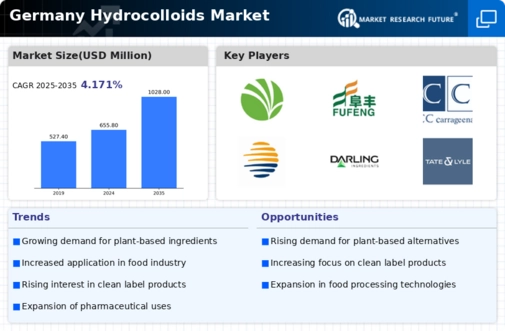Increasing Health Consciousness
The growing awareness of health and wellness among consumers in Germany is driving the hydrocolloids market. As individuals become more health-conscious, they seek products that offer functional benefits, such as improved digestion and reduced caloric intake. Hydrocolloids, known for their thickening and gelling properties, are increasingly utilized in food formulations to enhance texture while maintaining lower fat and sugar levels. This trend is reflected in the market, where the demand for hydrocolloids is projected to grow at a CAGR of approximately 5.5% over the next five years. The hydrocolloids market is thus adapting to meet these evolving consumer preferences, leading to innovative product development and increased market penetration.
Rising Demand for Plant-Based Products
The surge in demand for plant-based food products is a notable driver for the hydrocolloids market in Germany. As consumers increasingly adopt vegetarian and vegan diets, the need for plant-derived hydrocolloids has escalated. These ingredients play a crucial role in providing texture and stability in plant-based alternatives, such as meat substitutes and dairy-free products. The hydrocolloids market is responding to this trend by developing innovative solutions that cater to the unique requirements of plant-based formulations. This shift is expected to contribute to a market growth rate of around 6% annually, reflecting the changing dietary preferences of the German population.
Focus on Clean Labeling and Transparency
The emphasis on clean labeling and transparency in food products is significantly impacting the hydrocolloids market in Germany. Consumers are increasingly scrutinizing ingredient lists and seeking products with recognizable and natural components. Hydrocolloids, often derived from natural sources, align well with this trend, as they can be marketed as clean-label ingredients. The hydrocolloids market is likely to benefit from this shift, as manufacturers strive to reformulate products to meet consumer expectations for transparency. This focus on clean labeling may drive innovation in hydrocolloid applications, potentially leading to new product lines that cater to the growing demand for simplicity and authenticity in food ingredients.
Technological Advancements in Processing
Technological innovations in food processing are reshaping the hydrocolloids market in Germany. Advances in extraction and formulation techniques enable manufacturers to produce high-quality hydrocolloids with enhanced functional properties. For instance, the development of new extraction methods allows for the efficient recovery of hydrocolloids from natural sources, leading to a broader range of applications. This trend is particularly relevant as the hydrocolloids market seeks to meet the demands for clean-label products. As a result, the market is witnessing a shift towards more sustainable and efficient production processes, which could potentially increase the availability and reduce the costs of hydrocolloids in the coming years.
Expansion of the Food and Beverage Sector
The robust growth of the food and beverage sector in Germany significantly influences the hydrocolloids market. With a diverse culinary landscape and a strong emphasis on quality, the demand for hydrocolloids is on the rise. These ingredients are essential in various applications, including sauces, dressings, and dairy products, where they enhance texture and stability. In 2025, the food and beverage industry is expected to account for over 60% of the total hydrocolloids market revenue in Germany. This expansion is likely to be fueled by the increasing consumption of convenience foods and ready-to-eat meals, which often incorporate hydrocolloids for improved shelf life and consumer appeal.



















Leave a Comment